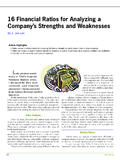Transcription of THE MARKETS STOCKS AND THE ECONOMIC …
1 8 AAII Journal/August 2003 THE MARKETSBy Wayne A. ThorpWhile STOCKS as a wholemove in advance of theeconomy, specificsectors have differentrelative performancethroughout theeconomic on thebusiness activities of agiven sector, there isgenerally a particularphase of the businesscycle that is morefavorable to thoseactivities than are AND THE ECONOMIC CYCLE:WHAT PERFORMS WELL AND WHENW ayne A. Thorp, CFA, is financial analyst at AAII and associate editor of the long run, a stock s price is driven by a company s ability to growsales and earnings. However, many factors can dictate whether a company issuccessful in this the last few years have shown, the economy can have a significantimpact on a company s financial success (or failure). Many companies haveseen their earnings fall because of the downturn in the economy and, conse-quently, the value of their shares has is not to say, however, that all STOCKS react the same way duringperiods of ECONOMIC expansion or article will explore the general characteristics of the ECONOMIC cycleduring its various stages.
2 It will also examine how various industries andinvestment styles react to these stages and how investors may be able to usethe ECONOMIC cycle to their advantage when developing an investment BUSINESS CYCLEOver long periods of time, the economy expands. During the 20thcentury, the growth rate of real GDP gross domestic product adjusted forinflation averaged approximately 3% a year. According to data provided bythe Commerce Department s Bureau of ECONOMIC Analysis, between 1929 and2000, GDP (in 1996 dollars) grew at an annual rate of However, thepattern of growth of today s modern economies has been uneven. During theperiod of 1929 to 2000, the maximum annual growth rate in real GDP in was from 1941 to 1942, and the lowest was a declinefrom 1931 to this data shows, no economy grows forever and, inevitably, economicgrowth and expansion wanes, followed by slowdown and even pattern of expansion and contraction in the economy is known as thebusiness business cycle can be further divided into its component parts.
3 Throughthe course of expansion, a point will be reached where most businesses areoperating at full capacity and real GDP is growing rapidly. This point in thebusiness cycle is the business peak. Then, as business conditions slow, theeconomy enters a period of decline or contraction, oftentimes referred to as arecession. During the period of contraction, sales of most businesses fall, realGDP growth slows or even declines, and unemployment increases. If therecession is prolonged and severe, it could be classified as a bottom of the contraction phase is referred to as a recessionary trough,after which ECONOMIC conditions begin to improve and the economy enters theexpansion phase of the business cycle sales rise, real GDP grows, andunemployment , EXPANSIONS & THE STOCK MARKETThe length of ECONOMIC cycles, including periods of recession and expan-sion, has varied significantly over the years.
4 The longest period of economicAAII Journal/August 20039 THE MARKETS decline from the business peak tothe recessionary trough since thebeginning of 1855 to March of1991, has been 65 months (fromOctober 1873 to March 1879). Thisdata is compiled by the NationalBureau of ECONOMIC Research(NBER; ), the organi-zation charged with declaring whenrecessions begin and the most commondefinition of recession is when GDPdeclines for two consecutive quar-ters, the NBER bases its announce-ments on elements such as employ-ment, industrial production, realpersonal income, and manufacturingand trade the flip side, the longest periodof expansion during this sameperiod from recessionary trough tobusiness peak has been 106months, from February 1961 toDecember 1969. Between 1965 and1991, the average length of eco-nomic expansion has been 35months although the average hasincreased in the postwar years to 50months.
5 Contractions over theperiod of 1865 to 1991 have aver-aged 18 months, falling to 11months since 1 shows the performance ofthe S&P 500 against the backdrop ofrecessions and expansions since1950. The shaded areas on the chartindicate recessionary to the NBER, we arecurrently in a recessionary phase ofthe ECONOMIC cycle, which began inMarch 2001. This places us in the30th month of contraction andcounting, beating the previouslongest postwar contraction by is a caveat to this, the time a reversal in theeconomy is announced either apeak or a trough the trend isusually months or even yearsdeveloped. Since 1980, the NBERhas announced four business peaksand three business troughs. Onaverage, there has been a seven-month lag between when a businesspeak forms and the NBER an-nounces its formation. The longestdelay was nine months between theformation of the July 1990 peak andthe announcement on April 25,1991, while the shortest was fivemonths between the January 1980peak and the announcement on June3, 1980.
6 For business troughs, thelag is even longer, averaging for the three that haveformed since 1980. Thelargest delay in an-nouncing a trough was21 months between theformation of the March1991 trough and theannouncement onDecember 22, shortest announce-ment gap was eightmonths between theNovember 1982 troughand the announcementon July 8, 1983.[For more on whatindicators to watch forclues on the businesscycle, see The Top 10 ECONOMIC Indicators:What to Watch andWhy, starting on page13 of this issue.]What does all thismean for the stockmarket?As a general rule, economicdeclines tend to have an adverseimpact on the overall stock marketand individual stock prices, althoughthere are exceptions, which we willdiscuss shortly. Specifically, datacompiled by Jeremy Siegel in hisbook STOCKS for the Long Run (Mc-Graw Hill Trade, 2002) showthat for the 42 recessions that haveoccurred since 1802, 39 werepreceded by stock market declines ofat least 8%.
7 For the period of 1948to 1990, during which there werenine peaks in the business cycle, STOCKS lost an average of 8%between the peak of the stock indexand the peak in the business lead time over this periodbetween the peak of the stock indexand the peak of the business cyclewas months. Furthermore,during this period, the 12-monthdecline in STOCKS following thebusiness cycle peak averaged Like all ECONOMIC andinvestment models, the stock marketdoes provide some false signals interms of predicting recessions. Siegelpoints to 10 times between May1946 and August 1998 when theDow Jones industrial average fell by19501955196019651970197519801985199019 95200010100100010000S&P 500 CompositeFIGURE 1. THE STOCK MARKET: RECESSIONS & EXPANSIONSS ource: S&P/Barra, National Bureau of ECONOMIC Research (NBER)10 AAII Journal/August 2003 THE MARKETSE conomic CycleBusiness CycleStageCharacteristicsIndustries That Do Well in This StageExamplesExpansion:Low, increasing inflationCyclicalsEarly StageLow, increasing interest ratesConsumer credit: Firms that are tied toSavings and loans, regionalHigh unused capacitythe housing industrybanksLow inventoryEnergy: Companies that produce energy-Oil, coalrelated productsConsumer cyclicals: Manufacturers ofAdvertising, apparel, autoconsumer products that respond to themanufacturers, retailerschanges in disposable incomeExpansion:Moderate inflationBasic materials.
8 CompaniesChemicals, plastics, paper,Middle StageModerate interest ratesmanufacturing materials (not machinery)wood, metalsModerate unused capacityto produce finished goodsModerate inventoryTechnology: Companies manufacturingSemiconductors, computerhigh-tech products for consumers andhardware, software and services,businessescommunications equipmentExpansion:High inflationCapital goods: Companies manufacturingEquipment and machineryLate StageHigh interest ratesmachinery used to produce finished goodsmanufacturersLow unused capacityFinancials: Firms tied to loans that are inCorporate and institutionalHigh inventorydemand due to ECONOMIC expansionbankersTransportation: Companies that transportAirlines, trucking, railroadgoods and passengersRecessionDecreasing inflationDefensiveDecreasing interest ratesConsumer staples: Manufacturers ofFood, drugs, cosmetics,Increasing unused capacitybasic consumer products that aretobacco, liquorDecreasing inventorypurchased at largely the same level throughall ECONOMIC cyclesUtilities: Regulated companies providingElectric, gas, waterproducts and services such as electricityIndependent ofVaried ECONOMIC circumstancesGrowthEconomic CyclesIndustries and companies in the early stageBiotechnologyof a life cycle: Expanding quickly and notsubject to ECONOMIC cyclesTABLE1.
9 THE ECONOMIC CYCLE AND INDUSTRY GROUPS more than 10%, yet no recessionoccurred in the following were nine business cycletroughs between 1949 and 1991,and during this time there was, onaverage, a lead timebetween the trough in the stockindex and the trough in the businesscycle. The average rise in the stockindex during this lead-time periodwas over This data bodeswell for the current economicenvironment. The Wilshire 5000, thebroadest index for equities, hasrisen (as of July 11, 2003)since bottoming out on March 11 ofthis year, just over four months THE BUSINESS CYCLEAs the data presented here indi-cates, there are opportunities tobenefit from properly timing peaksand troughs in the business , pinpointing these reversalsis much easier said than shows that, for the vastmajority of times, STOCKS fall prior torecessions. Therefore, a prudentinvestment plan would be to switchfrom STOCKS to Treasury securitieswhen an ECONOMIC downturn beginsand switch back to STOCKS once theprospects for recovery look , since World War II, if youwere to follow this plan and switchexactly at the ECONOMIC peaks andtroughs, you would have done onlyslightly better than a buy-and-holdstrategy.
10 Siegel states that if youmistimed your switch by only onemonth, you would haveunderperformed buy-and-hold a year. His research showsthat the maximum excess returngenerated by switching comes fourmonths prior to the business peak ortrough, which would have beat buy-and-hold by 4% a year. However,since it has taken economists anaverage of almost 14 months to calla business trough after it has formedsince 1980, it is virtually impossiblefor individuals to reap these excessAAII Journal/August 200311 THE is not to say that othermethods cannot be employed tobenefit from the business cycle. Thefollowing will discuss stock marketrotation the shift of assets from oneinvestment style, industry, or sectorto ROTATIONS ector rotation is movement fromone or more sectors into one ormore other sectors and is basedupon the premise that economiccycles exhibit characteristics thatimpact sectors or industries differ-ently during the stages of expansionand contraction.







